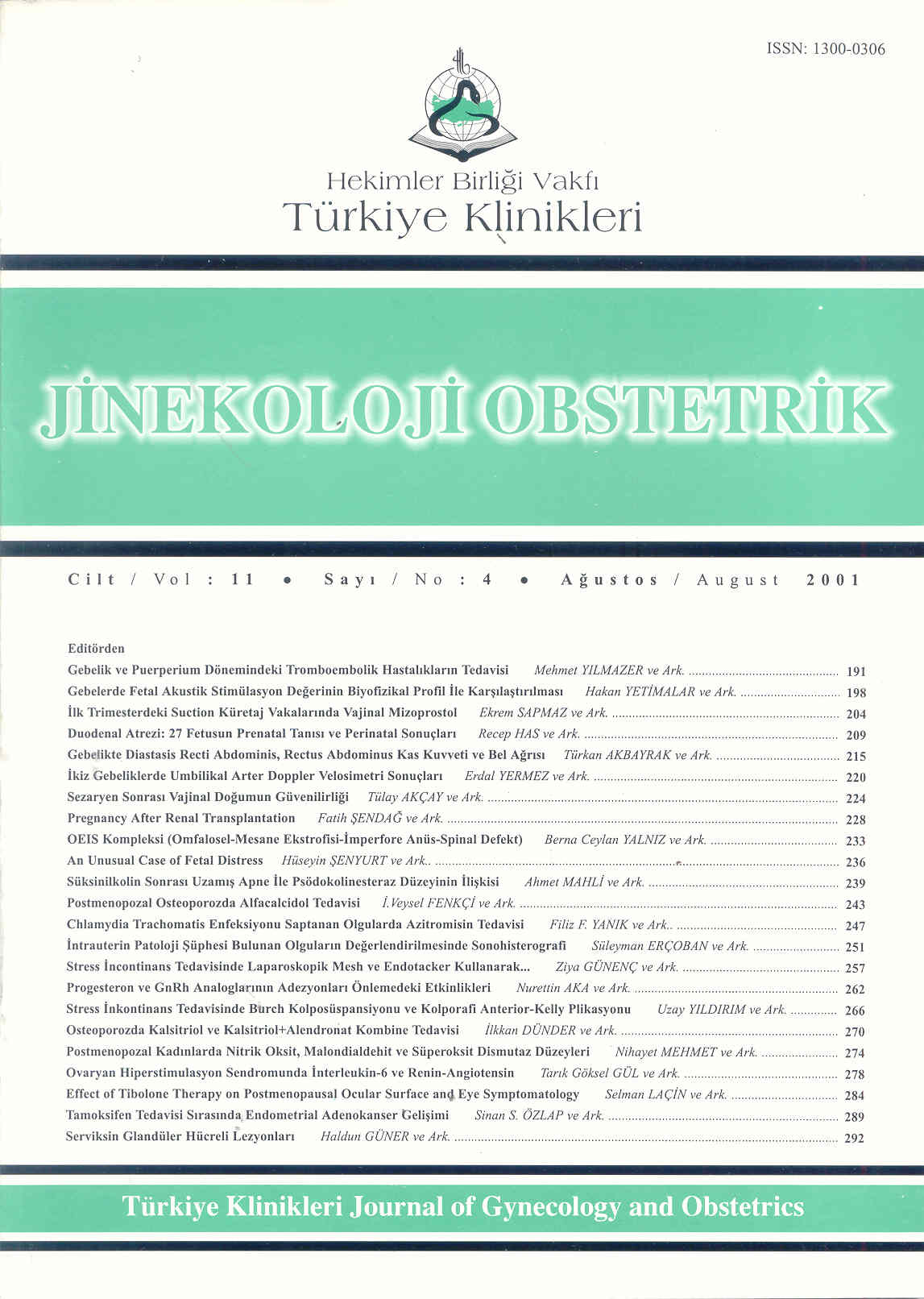Open Access
Peer Reviewed
ARTICLES
3175 Viewed1182 Downloaded
Comparison Of Combination Therapy Of Calcitriol And Calcitriol + Alendronate In Postmenopausal Osteoporosis
Postmenopozal Osteoporozda Kalsitriol ve Kalsitriol + Alendronat Kombine Tedavisinin Karşılaştırılması
Turkiye Klinikleri J Gynecol Obst. 2001;11(4):270-3
Article Language: TR
Copyright Ⓒ 2025 by Türkiye Klinikleri. This is an open access article under the CC BY-NC-ND license (http://creativecommons.org/licenses/by-nc-nd/4.0/)
ÖZET
Amaç: Postmenopozal osteoporozu olan hastalarda kalsitriol ile kalsitriol + alendronat kombine tedavisinin kemik turnover ve kemik yoğunluğu üzerine etkilerini karşılaştırmak. Materyel ve Metod: Eylül1998 - Eylül 1999 tarihleri arasında AÜTF Kadın Hastalıkları ve Doğum Kliniğine başvuran ve osteoporozu saptanan 78 hasta rasgele ya 0.5 mg/gün kalsitriol yada 0.5 mg/gün kalsitriol + 10 mg/gün alendronat kombine tedavisi almak üzere 2 gruba ayrıldı. Hastalardan tedavi öncesi ve sonrası kemik dansitometrisi ve biyokimyasal tetkikler istendi (serum kalsiyum, fosfor, alkalen fosfataz, üriner kalsiyum, serum osteokalsin değerleri). Bulgular: Tedavi sonrasında üriner kalsiyum düzeyi kalsitriol grubunda istatistiksel olarak anlamlı bir artış gösterirken (p<0.05), kombine tedavi grubunda anlamlı bir değişiklik saptanmamıştır. Kemik mineral yoğunluğu (BMD) değişim yüzdesi kombine tedavi alan grupta anlamlı olarak daha yüksek bulunmuştur (p<0.05). Sonuç: Kombine kalsitriol + alendronat tedavisi tek başına kalsitriol tedavisinden daha effektiftir.
Amaç: Postmenopozal osteoporozu olan hastalarda kalsitriol ile kalsitriol + alendronat kombine tedavisinin kemik turnover ve kemik yoğunluğu üzerine etkilerini karşılaştırmak. Materyel ve Metod: Eylül1998 - Eylül 1999 tarihleri arasında AÜTF Kadın Hastalıkları ve Doğum Kliniğine başvuran ve osteoporozu saptanan 78 hasta rasgele ya 0.5 mg/gün kalsitriol yada 0.5 mg/gün kalsitriol + 10 mg/gün alendronat kombine tedavisi almak üzere 2 gruba ayrıldı. Hastalardan tedavi öncesi ve sonrası kemik dansitometrisi ve biyokimyasal tetkikler istendi (serum kalsiyum, fosfor, alkalen fosfataz, üriner kalsiyum, serum osteokalsin değerleri). Bulgular: Tedavi sonrasında üriner kalsiyum düzeyi kalsitriol grubunda istatistiksel olarak anlamlı bir artış gösterirken (p<0.05), kombine tedavi grubunda anlamlı bir değişiklik saptanmamıştır. Kemik mineral yoğunluğu (BMD) değişim yüzdesi kombine tedavi alan grupta anlamlı olarak daha yüksek bulunmuştur (p<0.05). Sonuç: Kombine kalsitriol + alendronat tedavisi tek başına kalsitriol tedavisinden daha effektiftir.
ANAHTAR KELİMELER: Postmenopozal osteoporoz, kalsitriol, kalsitriol + alendronat tedavisi
ABSTRACT
Objective: To compare the effects of calcitriol and calcitriol + alendronate combination therapies on bone turnover and bone density in postmenopausal osteoporosis patients. Materials and Methods: Seventy-eight osteoporotic patients applied to Ankara University Faculty of Medicine, Gynecology and obstetrics Department between september 1998 and september 1999, were randomized to take either 0.5 mg/day calcitriol or 0.5 mg/day calcitriol + 10 mg/day alendronate combination therapies. Before and after the treatment, bone mineral dansitometer and biochemical markers (serum calcium, serum osteocalcin values) were studied. Findings: Urinary calcium level after the treatment increased, in a statistically significant manner in calcitriol group (p<0.05); whereas there was no statistically significant change in combination therapy group. A statistically significant increase was found in bone mineral density change percent in combination therapy group (p<0.05). Conclusion: Combination therapy of calcitriol + alendronate is more effective than calcitriol therapy in postmenopausal osteoporosis.
Objective: To compare the effects of calcitriol and calcitriol + alendronate combination therapies on bone turnover and bone density in postmenopausal osteoporosis patients. Materials and Methods: Seventy-eight osteoporotic patients applied to Ankara University Faculty of Medicine, Gynecology and obstetrics Department between september 1998 and september 1999, were randomized to take either 0.5 mg/day calcitriol or 0.5 mg/day calcitriol + 10 mg/day alendronate combination therapies. Before and after the treatment, bone mineral dansitometer and biochemical markers (serum calcium, serum osteocalcin values) were studied. Findings: Urinary calcium level after the treatment increased, in a statistically significant manner in calcitriol group (p<0.05); whereas there was no statistically significant change in combination therapy group. A statistically significant increase was found in bone mineral density change percent in combination therapy group (p<0.05). Conclusion: Combination therapy of calcitriol + alendronate is more effective than calcitriol therapy in postmenopausal osteoporosis.
MENU
POPULAR ARTICLES
MOST DOWNLOADED ARTICLES





This journal is licensed under a Creative Commons Attribution-NonCommercial-NoDerivatives 4.0 International License.










